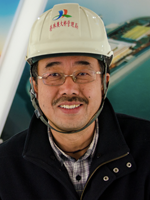Digital transformation of bridges inspection, monitoring and maintenance processes
Tulio N. BittencourtUniversity of Sao Paulo, Brazil
New communication and information systems and technologies ? known as ICT (Information and Communication Technologies) ? have immense potential to aggregate new functionalities and services to the management of infrastructure assets. This phenomenon, known as 'Digital Transformation', has influenced the evolution of various sectors of our society, such as the emergence of 'Industry 4.0'. New wireless communication technologies, such as 5G networks (large capacity communication, high reliability, great coverage and low consumption, for information processing and management ? such as Cloud Computing, Edge Computing, Big Data, Machine Learning and Artificial Intelligence ? are considered as the enabling technologies of this digital transformation, integrated with the concept of IoT(Internet of Things). High connectivity capacity and intensive automation enable, for example, changes in inspection paradigms and asset maintenance by transferring product focus to service platforms ('Everything' as a Service ? XaaS), bringing gains for efficiency, productivity, comfort and operational safety, as well as cost reduction. Bridges constitute an important part of the infrastructure and are subjected to damage caused by their continuous use over time. In addition to the effects of loading (fatigue, impacts, overloads, etc.), they are subjected to degradation of materials and support conditions, as well as exposure to adverse environmental conditions (storms, floods, gale, earthquakes, etc.). Scheduled inspections to assess their structural conditions are essential to ensure their proper use within the established safety limits. In other occasions, continuous or repeated monitoring of structural responses of bridges (displacements, vibrations and rotations at critical points) may add important information for decision-making regarding its maintenance, repair and reinforcement. The use of these data, together with techniques of structural reliability for the treatment of the uncertainties, allows predictions about the structural behavior to be elaborated with the consideration of different loading and degradation scenarios. The new ICTs can greatly contribute to the improvement of maintenance capacity and, consequently, to the reliability of the assets and to the operational availability of the system. Thus, the development of new predictive maintenance approaches, which make use of the large amount of data available, can improve the efficiency of maintenance processes, producing more accurate and reliable anticipated diagnostics. In this way, Digital Transformation can reduce maintenance costs (avoiding unnecessary maintenance events) and improve system availability, reducing operational losses. The use of Big Data Analytics, incorporating Artificial Intelligence and Machine Learning, are innovative solutions that can be introduced. The adoption of Digital Twins, that incorporate all these tools, can lead to a reduction in the total cost, allowing predictive and proactive maintenance. The concept of a Digital Twin for a railway bridge will be illustrated in this paper.












